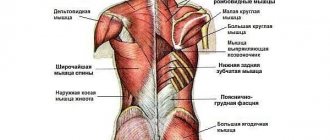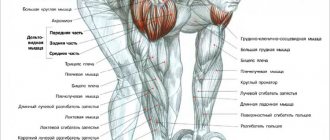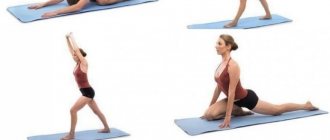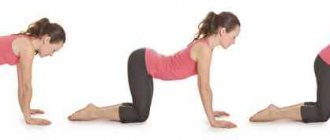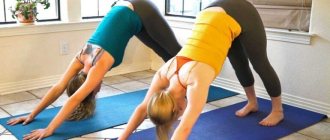Share:
When working in heavy sports - bodybuilding, weightlifting, powerlifting and, of course, CrossFit, the condition of the muscles before starting work plays a significant role. Even beginner athletes know that they need to warm up before starting a workout. But it is equally important to take care of their elasticity by stretching at the end of the lesson or on a separate day.
In this material, we will share with you the basics and best exercises for stretching the back in the gym and at home, which are also suitable for beginners.
Pros and cons of back stretching
Harm
Some athletes stretch before training, as part of their warm-up. This is not entirely correct, and here's why.
First of all, it should be noted that back stretching exercises negatively affect the athlete’s strength and speed. Perhaps this is the most unobvious fact, so we need to consider it from an anatomical point of view. When working in the gym (no matter what sport), the body activates the muscles. These same muscles consist of fibers that are unchanged in their quantity and can only grow under the influence of loads.
Many muscle fibers make up a dense, taut mass of leverage, due to which the athlete presses and pulls, and shows incredible miracles of strength and endurance. At the same time, stretching the back muscles causes the muscles themselves to stretch and become less tight. From an anatomical point of view, now in order to produce any action, the body must first compress the muscles and then unclench them at peak load. The spring principle works. What happens if the spring is first stretched strongly and then compressed back? Naturally, it will not be possible to obtain the same stiffness coefficient due to severe deformation.
This is why many athletes refuse to stretch their muscles before training, limiting themselves exclusively to warm-up approaches.
But we are talking exclusively about strong stretching (the kind that kickboxers, dancers, etc. do), which increases mobility in the joint. As for small warm-up stretching of the back and gymnastics, they in no way affect athletic performance.
And stretching after strength training or on separate days does not do any harm at all, only benefit.
© Starstuff - stock.adobe.com
Contraindications
The second reason why many athletes refuse stretching is contraindications. Of course, usually their list overlaps with sports, but few people pay attention to this.
Back stretching is not recommended if:
- arthritis;
- osteoporosis;
- pronounced kyphoscoliosis curvature of the spine;
- presence of injuries;
- presence of hernias;
- pregnancy at any stage;
- for other joint diseases.
As you can see, the list is quite large. And if you look carefully, most of the contraindications coincide with contraindications for intense physical activity.
Is it worth it?
Considering the negative factors associated with good back stretching, the question arises: is it worth it or not? If there are no contraindications, stretching after a workout or on a separate day is an excellent activity. She helps:
- relax muscles after strength work;
- remove metabolic waste that was created during training, which will lead to less muscle pain in the following days and you will recover faster;
- increase flexibility, which can also have a positive effect on strength training.
In addition, it improves the condition of the spine (which is especially useful for people with sedentary professions) and improves joint mobility, which is a necessary factor for achieving good results in any strength sport. So the conclusion is clear - for any sports activity, stretching the back is a necessity, not a whim.
Relaxation of the lumbar spine
This is where our favorite roller comes to the rescue again! It improves the condition of the entire musculoskeletal system, straightens posture, relieves spasms and tension. As a result, the spinal axis is aligned, pain disappears, the chest rises, lowered organs fall into place, blood circulation and even vision improves!
The cushion can be placed in several places, but if you are worried about stiffness in the lower back, place it in the waist area and lie there for at least 5 minutes every day.
As a result, your lower back will begin to feel better, and your waist will become narrower. Yes, this is another additional “bonus”.
Types of stretching
Having finished with questions about whether stretching is necessary, it’s worth going over what, exactly, you need to do? All exercises can be divided into three main categories:
- Warm-up stretching involves various turns of the body, slight bends, all in order to warm up the muscles before the approach.
- Dynamic stretching - we take a certain range of movements and stretch at an average pace.
- Static stretching – needed to improve overall flexibility.
The first and second types can be performed before training, and the third - after.
Let's take a closer look at the categories.
Warm-up stretching
First of all, such gymnastics includes exercises with body inclination.
Mill
The mill is a legendary exercise for stretching the back. Be sure to include it in your complexes from time to time. It consists of simultaneous tilting and twisting of the body:
Bends to the sides several times
Side bends are an excellent exercise that we are familiar with from physical education lessons.
Many people do this exercise with additional weight in hopes of removing the sides from their waist. This is ineffective and, on the contrary, will lead to the fact that the waist will grow, as the oblique abdominal muscles will increase. Leave this exercise for warm-up only.
Pelvic rotation
Pelvic rotations are also a classic warm-up exercise.
Contraindications
Back stretching is contraindicated in the following cases:
- For osteoporosis;
- In severe forms of thrombosis;
- During periods of exacerbation of arthritis.
You should be extremely careful if there are pathologies of the cardiovascular and respiratory systems.
During respiratory, intestinal and urogenital infections, training should be postponed until complete recovery.
If you feel weak or are in a bad mood, it is better to stretch. Exercise should be fun.
Dynamic stretching
Dynamic stretching partially overlaps with warm-up stretching, but the difference lies in the details of execution and a slightly different technique for similar movements.
Bends towards the legs with the toes touching the feet
Bending over is a great exercise for stretching your back. However, do it with caution and without sudden movements. The most important thing is to keep your back straight and not round in the lumbar region. It’s better not to reach the floor than to reach it with poor technique.
© fizkes — stock.adobe.com
Bends with hands touching heels through the back
Gently stretch back without sudden movements or jerks. A very useful exercise for back muscles and flexibility.
Alternate tilts
Alternate bending to the left and right legs with a wide stance is another classic exercise from physical education lessons.
Hyperextension without weight
Hyperextension is an excellent exercise for stretching the back. However, try to do it carefully and without fanaticism. It's perfect as a warm-up before heavy lifting.
© Makatserchyk — stock.adobe.com
Warm up the lower back muscles[edit | edit code]
back muscles deep lumbar muscles
The lower back muscles support the spine. Being sufficiently developed, they can relieve some of the load from the spine.
The lower back muscles are responsible for straightening the torso when we return it from a forward bending position. To perform this function, the lower back muscles usually contract together with the gluteal muscles and the posterior thigh muscles.
Research shows that low back pain is directly related to weakening of the lumbar muscles. Strengthening the muscles in the back of your back is the best way to reduce and prevent back pain. Therefore, it makes more sense to work your lower back muscles as a preventative measure than to deal with the pain once it starts to bother you.
Advice[edit | edit code]
Spine
- a fragile structure that becomes more susceptible to injury with age. Strength training can not only strengthen muscles, but also increase bone density. However, they can be dangerous for the spine. Therefore, always carefully perform exercises that place stress on the spine.
Warm-up for the lower back muscles
It is usually not recommended to start a workout with exercises for the lower back muscles. It is wiser to finish the workout with them so that they do not get tired ahead of time and can support the spine during exercise. This way, when you start doing exercises for the lower back muscles, you will be fully warmed up.
Exercises for the lower back muscles[edit | edit code]
Exercises for the lower back muscles that will be useful for women can be divided into two main categories:
- Deadlift.
- Hyperextension.
Each category consists of several variations of a core exercise, allowing you to choose the exercises that best suit your goals and anatomy.
Static stretching
What static stretching is is known to many who at one time wanted to do the splits. In the case of the back, the situation is approximately the same, only with the specifics of the exercises. Below are a few movements that are performed for static stretching.
The desire to touch your toes with your hands
Without jerking, maintaining a static position.
Exercise cat
A very useful exercise for your back and overall flexibility.
Pressing the front of your thighs without bending your knees
Hanging on the horizontal bar
It would seem that it could be easier than just hanging. Yes and no. Yes, it's easy. No – hanging long enough is not that easy. This exercise helps strengthen your back and grip. Perfectly relaxes the spine after training and a hard day. Track your progress and try to do a little more with each workout. It is optimal to hang for 30 seconds.
At the counter
- Stand sideways to the counter.
- With one hand that is closer to the counter, grab it, and bring the other one above your head and also grab the counter. Stretch out in an arc from the support.
- Move your pelvis in the opposite direction from the rack.
- Repeat for the other side.
Stretching the lower back muscles
- Sitting on your knees, stretch one leg in front of you, the other behind you and bend at the knees.
- One hand rests its palm on the floor, the other is raised up.
- Lean forward and twist towards your front leg.
Back Extensor Stretch
- We sit on a chair, bend our knees, resting our feet on the floor.
- Grasp the inside of your shins with your palms.
- Leaning forward, round your back. Ideally, you should bend as low as possible.
More information about the technique of back stretching exercises can be seen in the following video. An experienced instructor will tell you what mistakes can be avoided, what is best for beginners to start with, and most importantly, how to stretch so as not to harm your athletic achievements.
Warm-up complexes for stretching the back
Let's look at the main groups of movements and rules on how to stretch your back correctly.
Movement group No. 1: warm-up movements
The work in the warm-up is the most important, but at the same time its main task is not to stretch the muscles, but to prepare them for the upcoming loads. The best option for this would be to tilt the body.
How to do them correctly.
- Place your feet shoulder-width apart.
- Make a slight arch in your back or at least keep it straight.
- Relax your neck muscles.
- Slowly lean forward all the way and lean back from this position.
Everything is just like in physical education. The pace is set to be as comfortable as possible, at which you can achieve the greatest amplitude. Legs must be fixed; bending them is prohibited.
For the muscles of the upper back, you can use a similar exercise called “neck bends.”
The second exercise - the mill - is even simpler, we discussed it above. It is performed at a moderate pace, approximately 1-2 minutes. The speed increases to the maximum possible (while maintaining balance and arching in the back), and you need to touch the opposite leg with your hand.
Movement group No. 2: jerking movements
Exercises aimed at reducing the risk of injury require stricter adherence to technique. For those who have just decided to start doing serious stretching, an exercise familiar to everyone from school physical education lessons is suitable: you need to reach the tips of your toes with your fingers. Another similar exercise in which you need to reach your heels through your back is also very effective. The detailed technique for performing these exercises looks like this:
- Feet shoulder width apart.
- Slight arch in the back.
- Relaxed neck.
- Bend slightly, keeping your legs straight.
- Using jerking movements (not sharp), try to reach the floor or toes with your fingers.
There is also a similar algorithm, only through the back, here the legs can be bent. The back bend can also be performed while kneeling if it is difficult for you to do it at full height (this option was discussed above).
If the exercise seems too easy, try using your palms instead of your fingers, and then, as you develop skill, using your elbows. The main condition is not to bend your knees.
© undrey — stock.adobe.com
Movement group #3: static stretches
Classic exercises for stretching the back are static. They imply maximum load and, accordingly, an increase in the amplitude of work of ligaments, muscles and joints.
Classic exercise - reach the floor with your elbows:
- Feet shoulder width apart.
- Lack of rounded lower back.
- Completely relaxed neck, shoulders and lower back.
- Slowly stretch, trying to touch your elbows to the floor.
- Fix at the lowest point.
A simpler “sitting” exercise:
- Sit down, stretch your legs in front of you, spreading them wide to the sides.
- Relax your back and neck muscles.
- Slowly stretch first to your left leg, fixating at the peak point for 10-20 seconds.
© fizkes — stock.adobe.com
- Then return to the starting position.
- Stretch towards your right leg, similarly fixing yourself at the peak point.
- Return to starting position.
- Stretch straight forward with the same fixation.
© undrey — stock.adobe.com
Hanging on the horizontal bar
A separate exercise is hanging on the horizontal bar. It would seem that everything is very simple - hang, jump, ready. But at the same time, not only the back is stretched, but also the spine - which is important to consider when entering and exiting the apparatus:
- Grip selection. Medium closed grip.
- To approach the projectile, you will need a stool on which you can climb on and off the projectile.
- Grab the horizontal bar, then slowly lower your legs, keeping them suspended.
- Slowly rotate the body at the hip joint clockwise until it stops.
- Then counterclockwise until it stops.
- Perform as long as your wrists have enough strength.
- After finishing, do not jump off under any circumstances, but stand with your feet on the stand and get off.
The ideal option is to work until your wrists completely fail, the break time between approaches is up to 1-2 minutes. If the exercise falls on a training day, this stretching should be done after the main workout.
Content
- 1 Warm-up and stretching of the back muscles 1.1 Warm-up
- 1.2 Upper back stretch
- 2.1 Advice
- 4.1 Execution
Complete stretching complexes
Naturally, you can stretch as a form of exercise before performing basic exercises, or you can seriously take on the flexibility of your own back and put your spine in order. This is especially necessary for those who, for some reason, have minor spinal defects (scoliosis is no worse than the first degree) and want to straighten their back through the formation of a stable muscle connection and begin more serious loads.
In addition, stretching can be done on non-training days to improve movement control.
| Name of the complex | When to do it | Exercises |
| Base | Training day, warm-up |
|
| With a sedentary lifestyle | Non-training day | Hanging on the horizontal bar – 3-5 approaches for maximum time |
| Female 1 | Training day, warm-up |
|
| Female 2 | Non-training day or after training |
|
| Specialized stretching | Non-training day | Warm-up + non-training day (women's 2) 2-3 laps |
We straighten the spine yourself at home
Setting your own bones can be dangerous. Therefore, it is better not to self-medicate.
The only thing you can do with complete safety is lie on the cushion. It instantly puts your back in place and after class you keep your posture correct for several hours.
We have already described the magical properties of the roller above and truly consider it the best invention of mankind. Therefore, order it quickly on the website Beauty365.ru. And while you're waiting for your order, you can already start changing your back for the better by making a bolster with your own hands. Simply take a towel and roll it tightly into a roll about 10cm in diameter.
